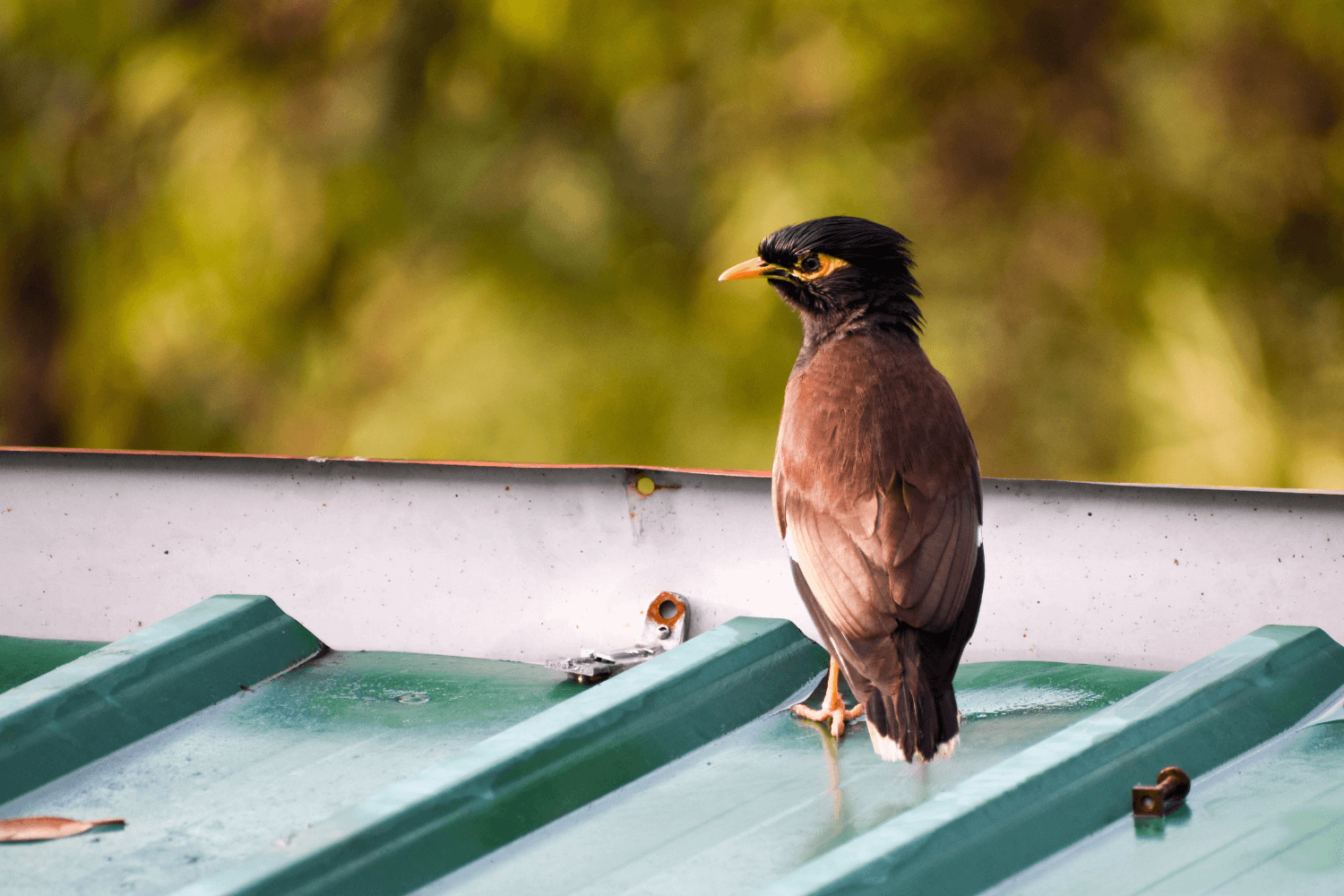Birds
Birds are beautiful. You will be delighted by simply watching them perch on your roof, and you will indeed feel revitalized to hear them make melodious flute calls. However, you will soon realize that these seemingly harmless creatures can cause all sorts of damage to your gutters and roof. This is why you should consider getting rid of the birds nesting in gutters and preventing future infestations.
Is Disturbing Birds Illegal?
Well, you could be breaking federal law by disturbing or removing bird nests from your home, but this doesn’t mean you can’t remove bird nests from your yard or home. Believe it or not, property owners have faced federal charges for disturbing or removing bird nests.
Ernesto Pulido, a tree trimmer based in Oakland (California), was charged with a misdemeanor following a violation of the United States Migratory Bird Treaty Act. Pulido trimmed several nest-laden trees for the United States Postal Service. A large colony of black-crowned night herons, one of the birds protected under federal government laws, had nested in the trees. Five birds suffered fractures and bruises.
In the United States, it is generally illegal to remove bird nests from trees or other structures. This law is designed to protect birds from being disturbed or displaced during their nesting season. However, there are some exceptions to this rule. If a nest is causing damage to property or posing a safety hazard, it can be removed.
Additionally, if the bird species are not protected by state or federal law, the nest can be removed without penalty. So if you are considering removing a bird’s nest, consult with a local wildlife expert to ensure that you are following the law.
What Birds build Nests in Gutters?
If you’ve ever wondered what kind of birds build nests in your gutter, you’re not alone. It’s a common question, particularly for property owners in the United States. Fortunately, the answer is relatively straightforward. Here are the most common bird species that build nests in gutters in the U.S.
House Sparrows
House sparrows are small, stocky birds with brown plumage and white bellies. They’re one of the most common bird species in North America and can be found in nearly every state. House sparrows typically build their nests close to the ground, making gutters an ideal nesting spot. If you have house sparrows nesting in your gutter, you may notice them flying back and forth to your gutter with pieces of straw or grass in their beaks.
European Starlings
European starlings are blackbirds with iridescent plumage that ranges from green to purple. They’re native to Europe but were introduced to the United States in the 1890s and are now one of the most populous bird species in North America. European starlings often build their nests near humans, as they like to nest in man-made structures such as eaves, porches, and, you guessed it, gutters.
If you have European starlings nesting in your gutter, you’ll likely see them flying to and from it with small twigs or bits of paper in their beaks.
Pigeons
Pigeons are medium-sized birds with gray plumage and white bellies. They’re commonly found around urban areas and are good at exploiting man-made structures for nesting sites. That’s why you’ll often see pigeons roosting on ledges or rooftops.
But pigeons will also nest in gutters if given a chance. If you have pigeons nesting in your gutter, you may see them entering and exiting your gutter with small sticks or leaves clasped firmly in their beaks.
Finches
Finches are a diverse family of small songbirds with colorful plumage that predominantly feed on seeds found in trees although some species do eat insects as well. They typically make small nests out of leaves, twigs, plant down, feathers, and spider webs.
There are many different species of finches, including purple finch, house finch, Cassin’s finch, pine siskin finch, and American goldfinch, just to list a few. These birds can be found all across North America except in parts of Alaska, Canada, and Mexico, where they do not reside year-round but migrate south during the winter months.
Why do Birds nest in Gutters?
Birds are often attracted to gutters because they offer a number of advantages as a nesting site. Gutters typically provide good protection from the elements and predators, and they can be easier to build a nest in than other types of structures. Gutters also tend to be located in areas where there is a reliable food source, such as insects or berries.
How to tell if there are Birds nesting in Gutters
If you think there might be birds nesting in your gutters, here are a few things to look for. First, look for telltale signs of nesting material. Birds will often use twigs, leaves, and grass to build their nests. If you see any of these materials in or around your gutters, there’s a good chance that birds are nesting. You may also notice an increase in bird droppings around your home.
Listen for chirping sounds coming from your gutters. If you hear birds singing or chirping, that’s a sure sign that they’re nesting in your gutters. Also, take a look inside your gutters. If you can safely get a look inside your gutters, do so. You may be able to see the nest itself, as well as any eggs or baby birds that may be present.
If you think there might be birds nesting in your gutters, don’t hesitate to call a professional to come and take a look. Trying to remove a nest yourself can be dangerous, and it’s always best to err on the side of caution when it comes to dealing with wild animals.
The problem with Birds nesting in Gutters
Birds may seem harmless. However, when they nest on your gutters and other parts of your home, they can damage your roof and gutter system. Understanding the damage birds can do to your home can help determine the best bird control and prevention techniques. Here are the reasons you don’t want birds nesting in your gutters.
Can Cause Clogging & Overflow
Depending on the type of bird, their nest can be made from different materials, including leaves, grass, mud, twigs, and even man-made items like synthetic strings or hair. These nests can block the flow of water and lead to clogging. Clogged gutters won’t drain properly, which means you will likely have an overflowing gutter system.
Can Cause Damage to your Home
Birds nesting on your gutters can cause significant damage to both your roof and your home. The weight of the birds and their nests can cause the gutters to sag and pull away from the house, and the droppings can stain and corrode the gutters. In addition, the bird’s claws can scratch and dent the gutters, making them more susceptible to leaks.
- Birds frequently leave behind droppings, which can stain and deteriorate asphalt shingles.
- If your roof has cracked or loose tiles, birds can exacerbate this problem.
- Bird’s nests are attractive to pests, which could quickly invade your home.
- Nests can block ventilation pipes, leading to trapped heat and moisture in your attic.
- Most bird nests can catch fire quickly.
- Nesting material can clog gutters and downspouts, leading to rainwater overflow and water damage.
Repeated bird nesting could result in old, rotting nests filled with dead chicks, rotting eggs, and excrement. This is unsightly, unpleasant, and presents a danger to human health. Even if you don’t know how to get rid of birds and their nests, contact a professional. You will get help.
Birds can be Noisy
Birds are lovely creatures that can add beauty and life to any backyard or garden. However, they can also be quite noisy, especially when they nest on gutters. The sound of their chirping can be very loud, and it can be difficult to get a good night’s sleep when birds are nesting in your gutters.
Along with tweeting, it is possible you’re going to hear birds’ claws scraping against your gutter system. This can go throughout the entire gutter length. When their eggs finally begin to hatch, the parents will be flying back and forth to find food for the little ones. Their noise can be a nuisance to the people living in your home.
Trapped in the Downspouts
If a grown or hatching bird tumbles into a downspout, the chances are that it will not get out itself. Crawling may not be possible because most downspouts are made of smooth metal, and the trapped bird doesn’t have enough room to fly.
Considering that most downspouts have a narrow exit, a bird can’t fit through it. And if your downspouts are attached to a French drain, the bird will be completely trapped. This will clog your system and cause the entire gutter system to become backed up.
How to get rid of Birds nesting in Gutters
Here are effective ways to get rid of birds nesting in gutter systems.
1. Install Gutter Guards
Installing gutter guards can help deter birds from nesting in your gutters and causing damage to your home. They work by creating a physical barrier between the bird and the gutter. Most gutter guards are made of metal or plastic and fit snugly over the top of the gutter. Some types of gutter guards also have spikes or bristles that make it difficult for birds to land on them. These features can help keep birds from nesting in your gutters and causing damage to your home.
In addition to preventing birds from nesting in your gutters and causing damage to your home, gutter guards can also help reduce the time you spend cleaning your gutters. If you have allergies or asthma, installing leaf guards can also help reduce your exposure to pollen, mold, and other allergens that can trigger an attack.
2. Use Predator Decoys
There is a relatively simple solution that does not require you to kill the birds or remove their nests: decoys. These are objects that are designed to imitate a real bird or animal. When placed in an area where birds are known to nest, they will often be fooled into thinking that the area is already occupied and will go elsewhere. This is an effective way to get rid of birds without harming them in any way.
You can use visual decoys. These are exactly what they sound like—objects that look like real birds. Common examples include plastic or rubber replicas of birds of prey, such as hawks and eagles. These types of decoys work best when they are placed in areas where the birds can see them clearly. By placing visual decoys in strategic locations around your property, you can deter birds from nesting without harming them in any way.
3. Trap the Birds and Relocate them
If you’re looking for how to get rid of birds, one method is to trap them and relocate them. This can be done by setting up a cage trap with food or water inside and then checking the trap regularly. Once you’ve caught a bird, you can then release it in a different area, away from your home or business. While this method takes time and effort, it’s a humane way to get rid of birds. And if done correctly, it can be an effective way to keep them from returning.
4. Use Sound Devices to remove nesting Birds
Auditory decoys emit sounds that birds find annoying or frightening, such as loud noises or recordings of predator calls. These decoys are most effective when placed close to areas where the birds nested in the past, as this will help reinforce the association between the area and the unpleasant noise. For best results, auditory decoys should be used in conjunction with visual ones.
5. Contact a wildlife control company.
If you’ve tried all of the above strategies and nothing seems to be working, contact a wildlife control company that specializes in bird removal. They will be able to identify the type of bird(s) that are causing problems and develop a customized plan for removing them from your property safely and humanely.
Prevent Birds from Nesting on your Home’s Roof and Gutters
As creatures of habit, birds tend to return to the same nesting spot year after year. So, if you have a bird problem, it’s likely that the birds have been nesting on your property for some time. To keep birds away, you need to take away their incentive to nest there in the first place. Here are a few things you can do;
Inspect your roof for gaps and holes
Birds are always looking for a safe place to build their nests, so they will take advantage of any openings in your roofline. To prevent this from happening, regularly inspect your roof for gaps and holes, and seal any that you find with caulk or another suitable sealant. If you are unsure of what you are looking for during the inspection, call a professional.
Trim trees and shrubs near your home.
Overhanging branches provide easy access for birds to get to your roof. To deter them, trim any tree branches or shrubs that are within six feet of your home’s exterior. If your yard is already infested with birds, find a professional who can handle the removal of birds’ nests safely.
Install bird netting over exposed areas of your roof
If you have an open patio or deck, cover it with bird netting to prevent birds from nesting there. The same goes for any other exposed areas of your roofline, such as skylights or vents. Be sure to secure the edges of the netting so that birds can’t slip underneath it.
Use scare tactics (temporarily)
You can also deter birds using visual or auditory scare tactics such as shiny Mylar balloons or tape strips, plastic owls or snakes, or recorded predator cries played on a portable speaker placed near the affected area. These devices won’t physically harm the birds but will help discourage them from nesting on or near your property. Again, these tactics should only be used temporarily, as birds will eventually get used to them if they see or hear them regularly.
Hang wind chimes near open areas.
The gentle tinkle of wind chimes can also help keep birds away—especially if they’re hung near an open area where birds might try to land. Again, this is only a temporary solution, as birds will eventually get used to the noise.
Install Gutter Guards
These handy devices create a barrier between the birds and your gutter system. They also help to keep your gutters clean and free of debris. In addition, gutter guards can also help to prevent other animals, such as snakes and rodents, from getting into your gutters. If you’re looking for a way to prevent birds from nesting on your gutters, installing gutter guards is a great place to start.
Conclusion
There are many reasons you might not want birds nesting in gutters or roofs. Luckily, there are several things you can do to deter them. By taking away their incentive to nest on your property and using some temporary scare tactics, you can help keep these feathered pests at bay – just in time for Spring.
FAQs
Do birds make nests in gutters?
Yes. Gutters typically provide good protection from the elements and predators, and they can be easier to build a nest in than other types of structures. They also tend to be located in areas where there is a reliable food source, such as insects or berries.
What are birds doing in my gutters?
Most birds consider gutters an ideal place to nest and raise their chicks. They favor safe, secluded places where they feel safe from predators, and your gutter system may be a safe haven. You may want to install gutter guards if you want to get rid of bird nests safely. Alternatively, you can call a professional who knows how to get rid of birds nesting in gutters.
How do I get rid of birds nesting in gutters?
First, you’ll need to remove any existing nests. This can be done by hand or with a long-handled brush. Next, you’ll need to make sure that your gutters are free of debris. This will help discourage birds from making their nests in your gutters. Finally, you may want to consider installing a gutter guard. This will help keep birds out of your gutters and prevent future nesting.




Hi, Thanks for connecting with you your service is realistic